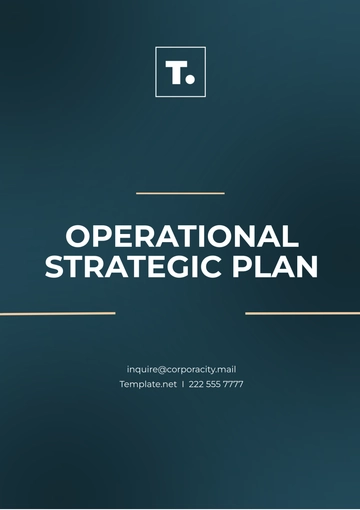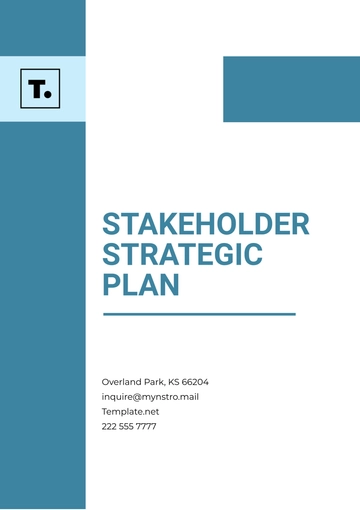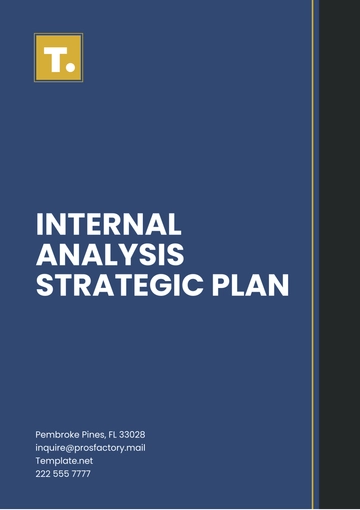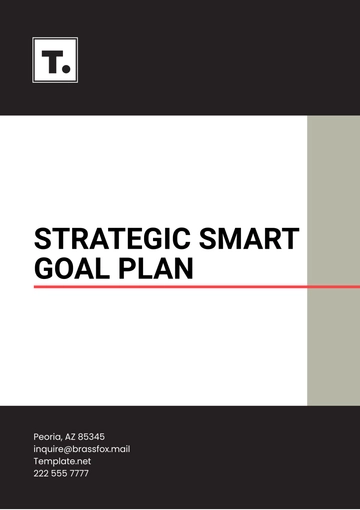Free Climate Change Strategic Plan

I. Executive Summary
A. Overview of the Strategic Plan
This Climate Change Strategic Plan serves as a roadmap to guide [Your Company Name] and its stakeholders toward a sustainable and climate-resilient future by 2055. It outlines strategies for reducing emissions, adapting to climate impacts, and fostering a low-carbon economy. The plan is aligned with global agreements such as the Paris Agreement and regional climate initiatives.
B. Purpose and Goals
The primary purpose of this plan is to achieve net-zero emissions by 2055 while building resilience in operations and communities. Goals include a [00]% reduction in emissions by 2053 and the implementation of adaptive measures to protect critical infrastructure. This plan also emphasizes biodiversity conservation and the promotion of sustainable development practices.
C. Key Findings and Recommendations
An analysis highlighted transportation and energy sectors as primary emission sources, constituting [00]% of the total in 2050. Key recommendations include transitioning to renewable energy, expanding electric vehicle infrastructure, and implementing reforestation projects. Stakeholder engagement and transparent monitoring are integral to achieving these goals.
II. Introduction
A. Importance of Addressing Climate Change
Climate change presents significant risks to ecosystems, economies, and human well-being. By 2050, extreme weather events and rising temperatures have increased vulnerabilities globally, affecting supply chains and resources. This strategic plan underscores [Your Company Name]’s commitment to proactive, sustainable action.
B. Scope of the Plan
This plan covers emissions reductions and adaptive measures across all operations, incorporating local, regional, and international initiatives. It aligns with sustainable development goals and emphasizes stakeholder collaboration and public education. The scope also includes risk management and innovation to address climate challenges effectively.
C. Alignment with National and Global Climate Goals
[Your Company Name] is aligned with the UN’s net-zero target by 2055 and the Paris Agreement’s 1.5°C goal. The plan also supports regional efforts like the 2040 Renewable Energy Accord. These alignments reflect the company’s leadership in sustainability.
III. Assessment of Current Conditions
A. Climate Profile of the Region
Historical Climate Data
Between 2000 and 2050, the region experienced a 1.8°C temperature increase. Precipitation patterns shifted, with a [00]% decline in winter rainfall and more frequent extreme summer storms. Sea levels rose by 12 cm, intensifying coastal flooding risks.
Projected Climate Trends
Projections for 2055 indicate a 0.7°C temperature rise, worsening heatwaves and droughts. Agricultural yields may decline by [00]% due to altered weather patterns. These trends necessitate comprehensive adaptation strategies.
B. Greenhouse Gas (GHG) Emissions Inventory
Table 1: GHG Emissions by Sector, 2050
Sector | Emissions (Million Tons CO₂e) | Percentage |
|---|---|---|
Transportation | 120 | 40% |
Energy Generation | ||
Industry | ||
Agriculture | ||
Waste Management | ||
Total |
C. Vulnerability and Risk Assessment
Key Climate Risks
Extreme weather events, such as hurricanes and heatwaves, have resulted in annual economic losses of $[00] billion. Energy grids and transportation networks remain vulnerable to disruptions. Water scarcity is expected to affect [00]% of the region by 2055.
Social and Economic Impacts
Marginalized communities face disproportionate climate risks, including displacement and economic instability. Healthcare costs linked to climate-related illnesses rose by [00]% in 2050. Adaptive strategies must prioritize equity to mitigate these challenges.
Natural Resource Impacts
Conservation has reduced deforestation rates by [00]% annually, yet biodiversity loss continues to escalate. Marine ecosystems are under strain, with fish populations declining by [00]% since 2030. Integrated resource management is critical to addressing these issues.
IV. Vision and Goals
A. Long-term Vision for Climate Resilience and Sustainability
[Your Company Name] envisions a future where operations and communities thrive sustainably, supported by resilient infrastructure and practices. By 2055, the company aims to lead in climate action and achieve net-zero emissions. This vision underscores a commitment to environmental stewardship and inclusive growth.
B. Measurable Objectives
The plan aims for a [00]% reduction in emissions by 2053 and net-zero by 2055. Additional objectives include fortifying infrastructure against climate risks and restoring biodiversity across key regions. Progress will be tracked through annual reports and verified by third parties.
V. Mitigation Strategies
A. Energy Transition
Transition to renewable energy sources by 2055 by scaling solar, wind, and geothermal systems. This initiative will decrease dependence on fossil fuels and stabilize energy costs.
Enhance energy efficiency in all facilities, reducing consumption by [00]% by 2053 through advanced technologies and retrofitting programs.
Deploy advanced energy storage solutions, such as grid-scale batteries, to ensure consistent renewable energy supply.
B. Sustainable Transportation
Expand electric vehicle (EV) infrastructure to achieve [00]% EV adoption across operations by 2053. Charging stations and incentives will accelerate the transition.
Invest in renewable-energy-powered public transit systems to reduce reliance on private vehicles. These systems will lower urban emissions and improve air quality.
Collaborate with suppliers to upgrade their fleets to low-emission or electric models, ensuring supply chain sustainability.
C. Waste Management
Enhance recycling and reuse programs, reducing landfill waste by [00]% by 2053. This includes optimizing waste collection and processing technologies.
Promote composting initiatives to reduce organic waste emissions and support sustainable agriculture. These programs will engage communities and create local benefits.
Build partnerships to develop markets for recycled materials, minimizing reliance on raw resource extraction.
D. Land Use and Forestry
Launch reforestation projects to plant 10 million trees by 2055, enhancing carbon sequestration and ecosystem restoration.
Strengthen conservation policies and introduce community-led monitoring to protect existing forests. These efforts will ensure long-term ecological health.
Integrate urban green spaces to combat urban heat islands and improve air quality. Green spaces will also foster biodiversity in urban environments.
VI. Adaptation Strategies
A. Infrastructure Resilience
Upgrade infrastructure with climate-resilient designs, including flood barriers and heat-resistant materials, to mitigate extreme weather risks.
Develop decentralized energy systems to improve grid reliability and ensure uninterrupted service during disruptions.
Introduce smart water management technologies to optimize usage in drought-prone areas and reduce water waste.
B. Ecosystem Restoration
Rehabilitate ecosystems like wetlands and coral reefs to provide natural buffers against climate impacts. This will enhance biodiversity and community protection.
Implement habitat restoration projects targeting endangered species and ecological corridors. These actions will support long-term ecosystem health.
Collaborate with local communities to adopt sustainable land management practices, fostering environmental stewardship and livelihood improvements.
C. Community Engagement and Education
Conduct public awareness campaigns on practical climate adaptation measures. These initiatives will empower individuals and communities to take action.
Organize workshops and training programs to enhance local capacity for resilience. Community-driven solutions will strengthen collective outcomes.
Partner with educational institutions to embed climate adaptation strategies in curricula, research, and outreach efforts.
VII. Implementation Framework
A. Governance Structure
The implementation will be overseen by a dedicated Climate Action Steering Committee comprising representatives from [Your Company Name], local governments, community organizations, and academic institutions. This committee will be supported by specialized subcommittees focusing on mitigation, adaptation, and stakeholder engagement. Monthly meetings will facilitate updates, decision-making, and alignment with overarching climate objectives.
B. Funding and Resource Allocation
Funding will be sourced from internal budgets, government grants, public-private partnerships, and international climate funds. An initial investment of $[00] million over the first five years will support priority projects. Financial performance metrics and quarterly reports will provide transparency and ensure funds are utilized effectively for maximum impact.
C. Timeline and Milestones
The plan includes specific timelines with actionable goals: short-term goals (2025-2030) will focus on infrastructure upgrades, mid-term goals (2031-2045) will emphasize achieving a [00]% emissions reduction, and long-term goals aim for net-zero emissions by 2055. Regular milestone reviews every six months will evaluate progress and identify areas needing course corrections. Achieving a [00]% renewable energy adoption in the first two years will be a critical early benchmark.
VIII. Monitoring and Evaluation
A. Performance Indicators
Performance will be assessed using detailed indicators such as the percentage reduction in greenhouse gas emissions, annual increases in energy efficiency, and participation rates in community climate programs. Indicators will also track the number of implemented renewable energy projects and their contribution to overall energy consumption. Independent audits will be conducted bi-annually to validate these metrics and ensure the credibility of reported outcomes.
B. Reporting Mechanisms
Annual progress reports will be comprehensively detailed, showcasing emissions data, achievements, and ongoing challenges. Reports will be supplemented with visual infographics and summaries for easier stakeholder comprehension. A web-based digital platform will provide stakeholders with real-time access to project progress, enhancing transparency and accountability.
C. Adaptive Management
Adaptive management strategies will be guided by a framework that integrates real-time climate data, technological advancements, and stakeholder input. Adjustments will be made every two years, ensuring the plan remains aligned with emerging challenges and opportunities. Partnerships with global research institutions will ensure that the latest scientific findings are incorporated into decision-making processes.
IX. Partnerships and Stakeholder Engagement
A. Public-Private Partnerships
Strategic collaborations with private-sector leaders will provide funding, technical expertise, and innovation for climate initiatives. Projects will include large-scale renewable energy installations, such as solar farms and offshore wind turbines, and advancements in green building technologies. These partnerships will significantly reduce costs while maximizing environmental and social benefits.
B. Community Involvement
Engagement efforts will prioritize inclusivity through multilingual workshops, online surveys, and accessible forums tailored to diverse community groups. Programs will highlight local success stories and provide resources for community-led sustainability initiatives. Empowering communities through active participation will foster long-term support and shared ownership of climate goals.
C. Collaboration with Academia
Collaborations with leading universities will establish research hubs focused on climate innovation, fostering joint research initiatives and student engagement. Academic partnerships will explore breakthroughs in carbon capture, advanced biofuels, and climate-resilient agricultural practices. These initiatives will ensure the plan is supported by cutting-edge research and cultivates future climate leaders.
X. Conclusion
A. Summary of Key Commitments
[Your Company Name] remains steadfast in its pledge to achieve net-zero emissions and bolster climate resilience by 2055. Through transitioning to renewable energy, implementing sustainable infrastructure, and conserving ecosystems, the plan outlines transformative actions. This strategic vision reflects a commitment to environmental responsibility and proactive leadership in addressing climate change.
B. Call to Action
The realization of this ambitious plan requires unified efforts from stakeholders, collaborators, and local communities. Everyone is encouraged to contribute ideas, resources, and active involvement to accelerate climate solutions. Together, we have the power to mitigate climate impacts and secure a sustainable, equitable future.
C. Looking Ahead
As a dynamic and forward-thinking organization, [Your Company Name] will continue to lead climate action through innovation, partnerships, and adaptability. Regular reviews and updates to the plan will ensure relevance amidst evolving global challenges. The vision for 2055 remains a harmonious world where prosperity thrives alongside environmental sustainability.
- 100% Customizable, free editor
- Access 1 Million+ Templates, photo’s & graphics
- Download or share as a template
- Click and replace photos, graphics, text, backgrounds
- Resize, crop, AI write & more
- Access advanced editor
Elevate your organization's environmental strategy with the Climate Change Strategic Plan Template from Template.net. This customizable and editable template empowers you to craft a comprehensive, actionable plan. Simplify your process using our AI Editor Tool, designed to seamlessly integrate complex data and insights, ensuring your strategy is as dynamic and impactful as the changes it addresses.





























